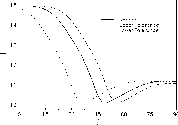
engineering & technology publications
ISSN 1759-3433
PROCEEDINGS OF THE TENTH INTERNATIONAL CONFERENCE ON CIVIL, STRUCTURAL AND ENVIRONMENTAL ENGINEERING COMPUTING
A Methodology for Minimum Weight Optimal Design of Fibre-Reinforced Laminated Structures Accounting for Manufacturing Uncertainties
Centre for Advanced Materials, Design & Manufacture Research, Durban Institute of Technology, South Africa
Optimal Design Problem and Solution Procedure
The objective of the design problem is to minimise the mass of the
plate, with manufacturing uncertainty in the layup angle | (25) |
where the mass of a plate is given by
When composite laminates are manufactured, the desired fibre orientation in
different plies may deviate from their intended design values by a few
degrees [1,2]. These deviations are referred to as manufacturing tolerances.
Assume that for the interval
![]() , a manufacturing
tolerance in the layup angle
, a manufacturing
tolerance in the layup angle ![]() is incurred. For example,
there may be a maximum variation band of
is incurred. For example,
there may be a maximum variation band of ![]() or
or ![]() , with
, with
![]() In order to
illustrate the problem, consider the following scenario: assume a
manufacturer incurs the following maximum tolerances,
In order to
illustrate the problem, consider the following scenario: assume a
manufacturer incurs the following maximum tolerances,
![]() and
and
![]() ; viz. when trying to achieve the value
; viz. when trying to achieve the value ![]() , the actual
value that results is
, the actual
value that results is
![]() . Figure
1 shows the effect of the tolerance on the minimum required plate
thicknesses for a (CCCC) laminated plate with four symmetric layers of equal
thickness and with
. Figure
1 shows the effect of the tolerance on the minimum required plate
thicknesses for a (CCCC) laminated plate with four symmetric layers of equal
thickness and with
![]() . There are three trendlines given, and these represent the nominal layer
thickness along with the upper and lower bands. The design problem becomes one of determining
the value of
. There are three trendlines given, and these represent the nominal layer
thickness along with the upper and lower bands. The design problem becomes one of determining
the value of ![]() at which the layer thickness is minimized thus
reducing the weight of the laminate, with the tolerances accounted for,
which effectively becomes one of determining the value of
at which the layer thickness is minimized thus
reducing the weight of the laminate, with the tolerances accounted for,
which effectively becomes one of determining the value of ![]() for
which the trend described by the upper composite line in Figure 178.1 is
minimised. The effect of manufacturing tolerances on the optimal lay-up orientation
for this plate is 51.43
for
which the trend described by the upper composite line in Figure 178.1 is
minimised. The effect of manufacturing tolerances on the optimal lay-up orientation
for this plate is 51.43![]() , which
corresponds to a plate thickness of 10.89 mm. The optimal values for the
nominal case are 48.84
, which
corresponds to a plate thickness of 10.89 mm. The optimal values for the
nominal case are 48.84![]() and 10.10 mm. It is apparent from this example
that the values of the actual optimal results are different from those of
the nominal, and that if we were to ignore the manufacturing tolerances and
choose 48.84
and 10.10 mm. It is apparent from this example
that the values of the actual optimal results are different from those of
the nominal, and that if we were to ignore the manufacturing tolerances and
choose 48.84![]() as the optimal fibre orientation, the corresponding
minimum thickness required could be as high as 11.32mm (viz. the value at
48.84
as the optimal fibre orientation, the corresponding
minimum thickness required could be as high as 11.32mm (viz. the value at
48.84![]() - 7
- 7![]() ), which is 12% more than the optimal value.
), which is 12% more than the optimal value.
The optimization procedure thus involves the stages of determining the
minimum layer thickness required for a given ![]() ,
, ![]() and
and
![]() to satisfy the constraint, selecting the greatest of the three values,
and improving the fibre orientation to minimise the greatest value. Thus,
the computational solution consists of successive stages of analysis and
optimization until convergence is obtained and the optimal angle
to satisfy the constraint, selecting the greatest of the three values,
and improving the fibre orientation to minimise the greatest value. Thus,
the computational solution consists of successive stages of analysis and
optimization until convergence is obtained and the optimal angle
![]() and layer thickness
and layer thickness ![]() is determined within specified
accuracy.
is determined within specified
accuracy.
- 1
- M. Walker, R. Hamilton, "A technique for optimally designing fibre-reinforced laminated plates with manufacturing uncertainties for maximum buckling strength", Eng. Opt, 37(2), 135-144, 2005. doi:10.1080/03052150412331298371
- 2
- M. Walker, R. Hamilton, "A methodology for optimally designing fibre-reinforced laminated structures with design variable tolerances for maximum buckling strength", Thin Walled Structures (In Print). doi:10.1016/j.tws.2004.07.001
purchase the full-text of this paper (price £20)
go to the previous paper
go to the next paper
return to the table of contents
return to the book description
purchase this book (price £135 +P&P)
